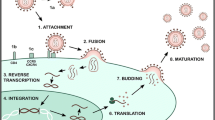Abstract
A 3-(4,5-dimethylthiazol-2-yl)-2,5-diphenyltetrazolium bromide microplate assay was adapted to screen for the ability of 20 host-defense peptides to inactivate herpes simplex virus type 1 and type 2. The procedure required minimal amounts of material, was reproducible, and was confirmed with standard antiviral testing techniques. In screening tests, with the exception of melittin, a highly cytotoxic and hemolytic peptide found in bee venom, the α-helical peptides in our test panel (magainins, cecropins, clavanins, and LL-37) caused little viral inactivation. Several β-sheet peptides (defensins, tachyplesin, and protegrins) inactivated one or both viruses, sometimes with remarkable selectivity. Two peptides were identified as having antiviral activity against both viruses, indolicidin (a tryptophan-rich peptide from bovine neutrophils) and brevinin-1 (a peptide found in frog skin). The antiviral activity of these two peptides was confirmed with standard antiviral assays. Interestingly, the antiviral activity of brevinin-1 was maintained after reduction and carboxamidomethylation, procedures that abolished its otherwise prominent hemolytic and cytotoxic effects.
Similar content being viewed by others
Author information
Authors and Affiliations
Rights and permissions
About this article
Cite this article
Yasin, B., Pang, M., Turner, J. et al. Evaluation of the Inactivation of Infectious Herpes Simplex Virus by Host-Defense Peptides. EJCMID 19, 187–194 (2000). https://doi.org/10.1007/s100960050457
Issue Date:
DOI: https://doi.org/10.1007/s100960050457




